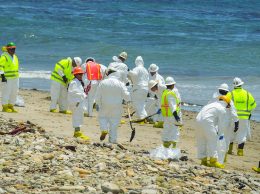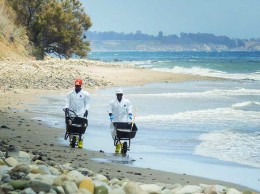Dubroff: South Coast oil production could be off-line for very long time
IN THIS ARTICLE
- Columns Topic
- Henry Dubroff Author
By Henry Dubroff Friday, September 18th, 2015
Houston, we have a problem.
More than three months after a Plains All-American Pipeline pipe burst, spilling thousands of gallons of oil into the Pacific Ocean near Santa Barbara, a big chunk of the region’s oil and gas industry remains shut down.
That’s partly because there is simply no way for ExxonMobil, Venoco and Freeport-MacMoran to move oil from onshore and offshore facilities through the shuttered pipelines through Santa Barbara County to gathering facilities in Kern County.
Ironically, it is not the pipeline that caused the 140,000-gallon oil leak that’s the main issue when it comes to restarting production. That pipeline, known as Line 901, is just 10 miles long and, if necessary, could be dug up and completely replaced in a matter of months. Line 901’s walls famously had corroded to a thickness of just a sixteenth of an inch and a six-inch long rupture caused the Refugio oil spill.
Today, the bigger headache for Houston-based Plains, oil producers, regulators and Santa Barbara County government, is Line 903. It is a much longer line, running 128 miles between Gaviota and Kern County.
A 2013 report by the Department of Transportation’s Pipeline and Hazardous Materials Safety Administration cited 99 instances of “metal loss anomalies” in Line 903 that required further investigation. That was for just a 38-mile section of the pipe that runs from Gaviota to Sisquoc Station in the North County.
A 75-mile section from Sisquoc Station to Pentland Station examined at about the same time identified unspecified “metal loss anomalies” that could be the result of general corrosion. And the final 15-mile segment from Pentland Station to Emidio Station found two problems with pipe welds that merited investigation.
On Sept. 11, DOT officials wrote to Plains stating that the failure to keep records and properly document tests could be a violation of pipeline safety regulations. Specifically, the DOT wrote that Plains had failed to document “preventive and mediative” evaluations for the Sisquoc to Pentland and Pentland to Emidio pipeline segments of Line 903.
Plains also didn’t document its review of emergency procedures as required and train people in emergency response, the government said in its Sept. 11 letter. The government said it was not prepared to fine Plains for the violations “at this time.”
A reading of the correspondence from the pipeline officials indicates that Plains never really got the message that pipelines need to be maintained to a standard that minimizes risk to the public.
Instead, business as usual at Plains was to allow Lines 901 and 903 to deteriorate and assume that they would work or that insurance would pick up the tab in the case of a spill.
That assumption came with a fatal flaw — nobody at Plains appears to have expected that Line 901 would break next to a culvert and leak thousands of gallons of oil into the ocean.
Right now it’s a waiting game as the DOT prepares its analysis of what went wrong and a separate corrective action order that spells out what has to happen to get the two pipelines running.
There’s a lot at stake in what the government orders in the way of a fix. There’s every reason to think Plains shouldn’t be allowed to pursue the business as usual practices that led to undocumented corrosion, poor safety training and, ultimately, a very nasty spill.
The shutdown of Line 903 hurts Santa Barbara County, where tax revenue from oil production is needed to fill some deep holes, including increased pension obligations. It also means oil workers aren’t working.
For oil companies, it’s more of a mixed blessing. With oil prices in the $50 per barrel range, there’s less profit in production than there was a few years ago.
Until Plains All-American sends some real signals that shoddy oversight will no longer be the case for Lines 901 and 903, most of the South Coast’s oil production is going to remain off-line.
Perhaps for a very long time.
• Reach Editor Dubroff at [email protected].











